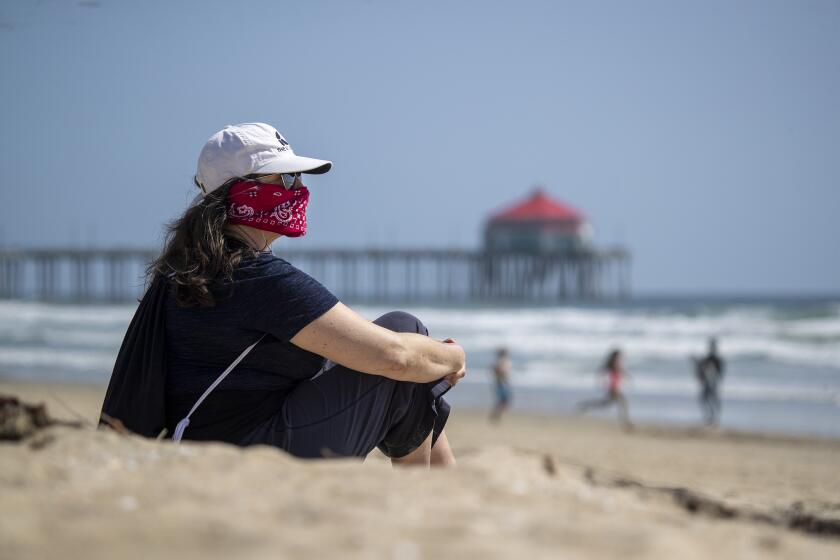In the Pipeline: Bartlett Park a blemish on the city
On a balmy, breezy and drizzly morning, Suzanne Messina-Cervellone walked me around Bartlett Park.
The 28-acre park, located just behind the Newland House along Coldwater Lane, is a hilly, rugged and densely overgrown oblong plot that occupies land once owned and farmed by some of Huntington Beach’s earliest settlers.
It is where the bodies of two men were discovered in July after an apparent murder-suicide. That event forced yet another examination of the park, which in recent years has become more like an apocalyptic land of the lost.
Elaborate homeless encampments featuring structures made of wood and tarp have become quite common throughout the maze of jungle-like black willow and eucalyptus trees.
I was first contacted by local Mike Cohen, who reinforced a few things I’d been hearing about the park over the years. He and Messina-Cervellone have become point people of sorts, helping to focus attention on and, most importantly, generate action to help reclaim the park so that those in the community can enjoy it.
The gloominess of the day that Messina-Cervellone and I chose to explore the park (with her dog, Roxy) did nothing to ease the tension one feels when pushing blindly through brush without knowing what waits on the other side.
We reached one wide clearing and Messina-Cervellone, who has an 8-year old son, explained to me that this is where, on Sept. 21, a city-sponsored cleanup crew had helped sweep the area. Today, barely one month later, bags, bottles, cans and other refuse are strewn about.
Nearby, a crude shrine marks the spot where the two bodies were discovered. (As I wrote recently, I find memorials like this interesting and necessary because they help us mark city history.)
In next week’s column, I will go into more depth after speaking with officials about what efforts are being taken to try to regain control of the park, a place that finds itself snared in a Catch-22 of conflicting local, county and state — Department of Fish and Wildlife — regulations.
But even as we tramp along the spongy hidden trails, Messina-Cervellone lets me in on a few things. For instance, the squatters and vagrants living throughout the park must be given a three-day notice of evacuation before city officials even come in to clean up.
It seems obvious why the transients surge back. At the top of the ridge, the park backs up to several restaurants and supermarkets, all of which have dumpsters out back. Those dumpsters, more often than not, contain food. So it’s an easy hop for squatters to hike up the hill, raid the containers and scurry back to their private forest.
The morning Suzanne and I were there, people were plainly visible heading up the hill and then back down. In one hidden camp, you could barely detect several bodies as they moved to take cover when they heard us approaching.
The neighborhood has become accustomed to shadowy figures parking on the streets and heading at night to the encampments, where officials believe drugs are sold. The garbage from the camps blows into the neighborhoods.
There are no sightlines, given the density of the overgrowth, so forget letting your kids wander in there to walk the trails. Campfires in the park have resulted in several nearby roofs catching fire.
In one thick and isolated cluster of trees, an encampment had been cleared back in September. Now, giant blue tarps are clearly visible, as are the squatters.
Up until the mid-2000s, the park had gained notoriety as “Hidden Valley,” a place where BMX bike riders came from all over the country to ride massive makeshift jumps carved out of the hillside. The bikers were run out in 2008 when the city stepped in and regraded the hills to prevent any more daredevil biking activity.
However, many locals seem to believe that the bikers actually helped keep the homeless population in check. In their absence today, the park is getting crowded with squatters. It is also becoming overrun with vermin, human waste and other unsanitary garbage.
Additionally, the overgrowth provides great cover for the more garden-variety social ills, like underage drinking. The park’s neighbors feel the sting of all this as they take in the stench.
The good news is City Hall seems more responsive lately to the blight that is Bartlett Park. Still, in my column next week I hope to have some specific plans.
Ted Bartlett, mayor of Huntington Beach in the 1940s and a councilman for 20 years, was a native of North Dakota. He arrived here in 1925 and over time became known as the city’s goodwill ambassador because of how much he loved the area.
His name deserves better, as do the residents near Bartlett Park.
CHRIS EPTING is the author of 19 books, including the new “Baseball in Orange County,” from Arcadia Publishing. You can chat with him on Twitter @chrisepting or follow his column at https://www.facebook.com/hbindependent.
[For the record, 1:23 p.m. Nov. 5: An earlier version of this story incorrectly reported that squatters and vagrants living throughout the park must be given a 12-day notice of evacuation. It is actually three days.]
All the latest on Orange County from Orange County.
Get our free TimesOC newsletter.
You may occasionally receive promotional content from the Daily Pilot.



